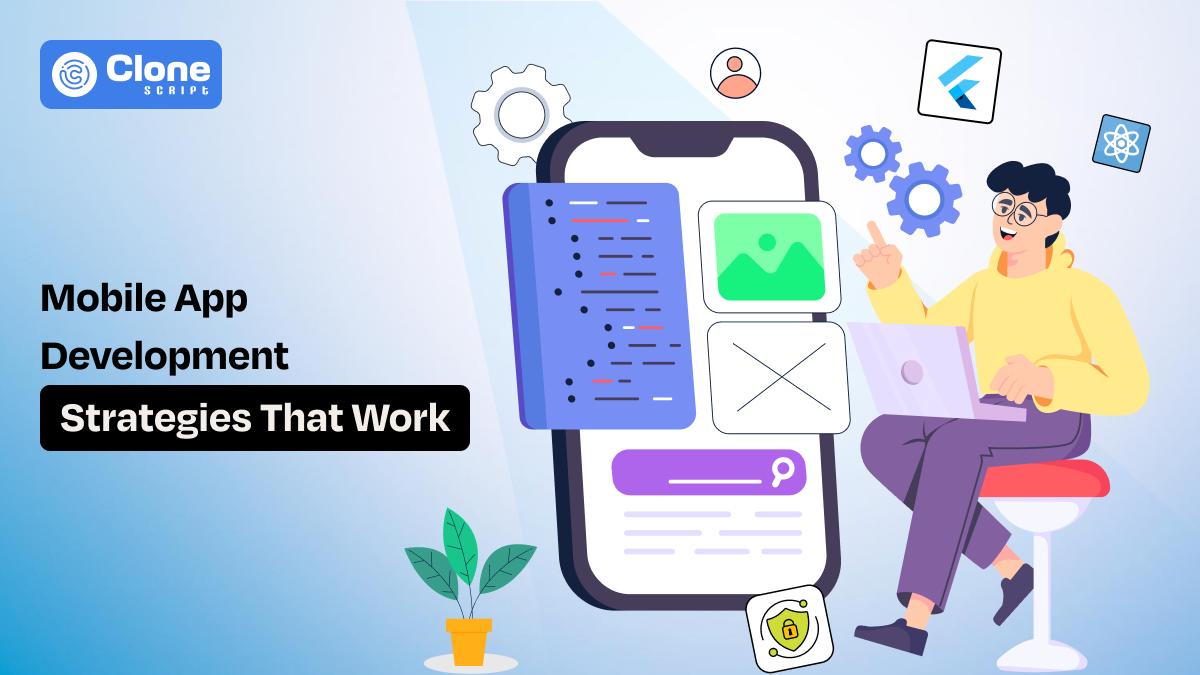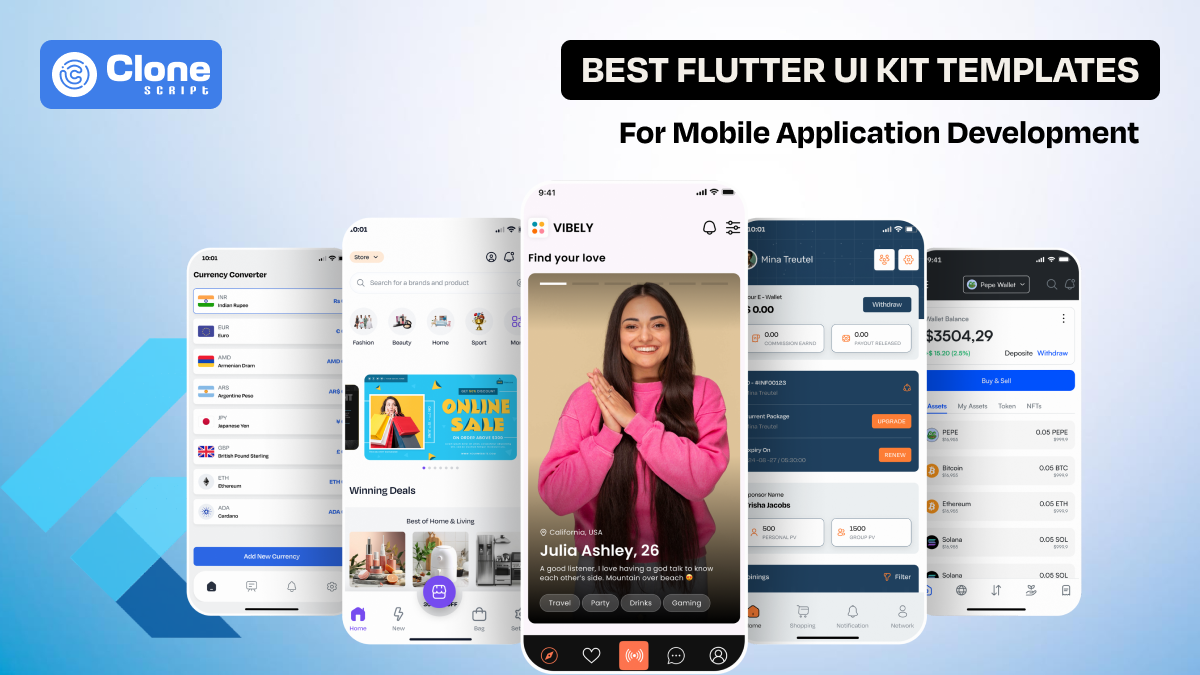10 Mobile App Development Strategies That Actually Work in 2025
The mobile app technology industry in 2025 is more competitive, secure, and complex than ever before. With billions of devices, emerging technologies like AI, blockchain, and wearable integrations, developers face a dynamic challenge: how to launch high-quality new apps faster without sacrificing performance, security, or user experience.
A decade ago, mobile development was largely about mastering iOS or Android separately.
Today, it’s about building with the right frameworks, using reusable components, implementing user-centric design, and architecting for scalability from day one. Whether you're a solo developer, working in a team, or part of an enterprise, a defined mobile app development strategy is critical to success.
In this article, we’ll go beyond the basics and uncover 10 mobile app development strategies that work in 2025. These strategies are curated for modern developers who want to build secure, scalable, and engaging apps without wasting time or budget.
Why Are Mobile App Development Strategies Required?
Let’s get one thing straight: the app stores are saturated. On average, over 3,000 apps are published daily on the Google Play Store alone. Most apps either never gain attention, suffer from poor UX app design, fail security audits, or drain resources due to a lack of scalability.
A solid development strategy ensures:
-
Alignment with actual user needs and behavior
-
Faster time-to-market through reusable components and smart tooling
-
Fewer app bugs and smoother updates post-launch with professional QA & Testing
-
Measurable ROI for clients or stakeholders
-
Competitive advantage via security, speed, and design
For developers, a strategic mindset ensures you don’t waste time building the wrong features and helps you navigate through technical debt, app performance, and long-term maintenance.
Now, let’s explore the top strategies that are making a difference in 2025.
Top 10 strategies for quick and secure app development
Here is a list of top strategies used by agile developers to achieve the best product output in app development:
-
Identify your audience
-
Offer genuine value to customers
-
Define the app’s business model
-
Choose the right technologies and development approach
-
Use Pre-Built App Templates
-
Design a simple and intuitive UX/UI
-
Test Thoroughly on Real Devices
-
Plan a marketing strategy
-
Make regular updates
-
Work on user retention
Eager to understand them in detail? Let’s get started.
Strategy No. 1. Identify your audience.
Your app idea should solve a real problem for a specific group of users. Defining your target audience early helps shape the app’s features, tone, functionality, and business model. Without this clarity, development efforts miss the mark and may result in product failure.
User persona in app development not just helps the coding team but ensures it has been created for potential users, not others.
How to do it:
-
Create user personas: Define your ideal users by age, profession, habits, goals, and pain points.
-
Use data tools: Platforms like Google Analytics, Firebase, and Mixpanel can reveal who your users are and what they want.
-
Engage communities: Reddit, Quora, Discord, or niche forums offer honest feedback and help you validate assumptions.
-
Run surveys or interviews: Directly talk to potential users to uncover expectations and behaviors.
Focusing on a well-defined audience improves user satisfaction, speeds up feature prioritization, and allows for better retention strategies down the line. It will also help to craft the best app design that generates curiosity in users’ minds and revenue for your mobile app business.
Strategy No. 2. Offer Genuine Value to Customers
People don’t download apps. They download solutions. To stand out in 2025’s saturated app market, your app must deliver real value from day one.
It’s not about packing features; it’s about providing outcomes.
In other words, your application listed on the Google Play Store and App Store has a sophisticated customer value just like a USP (Unique Selling Proposition).
Don’t know how to create an app USP? Here are the best ways to choose:
-
Solve a specific problem: The more urgent or painful the issue, the more indispensable your app becomes. For example, Google Pay became the most downloaded Android app in India for online bill and UPI payments with advanced security solutions.
-
Save time or money: Looking for budgeting, automation, or productivity tools, then it relates closely to users. So, think as a user, what do you need to do?
-
Deliver convenience: Designing an app for on-demand services like easy booking and real-time tracking is a prime example to initiate with.
-
Evoke emotion: Entertainment apps that trigger joy, community apps that offer connection, and wellness apps that provide calm. Decide what your mobile app business category.
Focus on the “aha moment.” That instant when users realize your app helps them do something better, faster, or easier. If you can consistently deliver that, users will keep coming back.
Strategy No. 3. Define the App’s Business Model
Without a sustainable business model, even the best app ideas eventually fail. Choosing how your app will generate revenue influences your tech stack, feature scope, marketing plan, and growth trajectory.
Popular monetization models in 2025:
-
Freemium with in-app purchases (IAP): It comes with basic features, accessibility, and is completely free to use. For advanced features, users have to pay.
-
Subscription-based: Recurring monthly/yearly plans work well in wellness, finance, entertainment, and AI apps. Netflix, LinkedIn, and ChatGPT are the prime examples of this app’s monetization method.
-
Ad-supported: It requires high user volume and works for entertainment or news. You can choose this method if you intend to generate more revenue by allowing display ads.
-
One-time purchase: Useful for premium B2B tools or offline utility apps. The startup app that offers a premium service offers a one-time purchase monetization.
-
Web3/tokenized: Let users unlock features or content via tokens or NFTs (growing in crypto and gaming spaces). This can be a good choice for crypto swapping and DEX apps.
Your model should reflect user behavior and expectations. Don’t force ads in a productivity app; don’t use subscriptions for single-use utilities. Design with revenue in mind. But never at the cost of user trust.
Strategy No. 4. Choose the Right Technologies and Development Approach
Your choice of app development tools and stack directly affects your app’s performance, scalability, and maintenance costs. In 2025, balancing speed with long-term flexibility is crucial.
Consider these options:
-
Native development: Swift (iOS) and Kotlin (Android) offer the best performance and integration.
-
Cross-platform: React Native and Flutter allow shared codebases for faster development.
-
Low-code platforms: Tools like Adalo, Thunkable, and Glide are ideal for MVPs or non-technical founders.
Backend choices:
-
Firebase, Supabase, Node.js with Express, or Python (Django/FastAPI)
-
Serverless functions via Google Cloud or AWS Lambda
Other tech stack decisions:
-
Use AI-assisted coding (e.g., GitHub, Copilot X) for faster iteration.
-
Choose secure, scalable databases like PostgreSQL or Firestore.
-
Integrate APIs for payments (Stripe), analytics (Mixpanel), and auth (Auth0 or Firebase).
Build what makes sense for your timeline, budget, and audience, not just what’s trending.
Strategy No. 5. Use Pre-Built App Templates
In 2025, developers are optimizing time and cost by leveraging professionally designed, pre-built app templates, especially Flutter app templates. These templates accelerate development without compromising quality.
Why use templates:
-
Speed: Jumpstart your project with a working layout and core features.
-
Cost-effective: Save money compared to building everything from scratch for Flutter app development.
-
Tested UI/UX: Templates come with clean app interfaces and mobile-first experiences.
-
Built-in integrations: Many include Firebase, Stripe, and social auth options, enabling your mobile app to launch quickly and perfectly.
Popular sources:
-
All Clone Script, Creative Tim, CodeCanyon, ThemeForest, UI8, and bespoke template agencies
-
Choose templates built in React Native, Flutter, or Swift based on your stack
Use templates to reduce repetitive tasks and focus your energy on building custom features that offer a competitive advantage.
Strategy No. 6. Design a Simple and Intuitive UX/UI
Design can make or break your app. A simple, clean, and intuitive interface ensures users stay longer and return for more. In 2025, mobile app development minimalism with purpose dominates.
There is a difference between app UI and UX design to be understood.
Key principles for effective UX/UI:
-
Prioritize clarity: Use white space, readable fonts, and clear labels. Don’t confuse users, as they want immediate help.
-
Design for thumbs: Place controls within easy reach on mobile screens. Your app UI design has to be easily absorbed through a thumb on smaller to larger devices.
-
Use motion intentionally: Subtle animations create delight and enhance feedback. It becomes an integral part of new app designing, especially a finance, gaming, and shopping.
-
Optimize for accessibility: Support screen readers, color contrast, and adjustable text size. So, every user can access your app and get help to complete the required action.
-
Implement dark mode: It's not optional anymore, it’s expected. Most Android and iOS applications have this feature to maintain tech-savvy users on board, reducing eye strain.
Tools for modern UI design:
-
Figma + Auto Layout
-
UXPin or Framer for prototypes
-
Accessibility testing with Stark or A11y
Design with empathy. If users have to think too hard to use your app, they’ll delete it without hesitation.
Strategy No. 7. Test Thoroughly on Real Devices
Testing on simulators alone is risky. In 2025, users will run your app on thousands of devices with different screen sizes, chipsets, network speeds, and permissions. Real device testing is non-negotiable.
App testing checklist:
-
Functionality: Every button, input, and API response should work reliably.
-
Performance: Watch out for slow loads, UI lag, or memory leaks.
-
Battery & network usage: Avoid draining power or using excessive mobile data.
-
Permissions: Ensure proper handling of location, camera, microphone, etc.
-
OS compatibility: Test on the latest and older versions of Android/iOS.
If you find any bugs in the app related to these issues, then report them to the app developer immediately. Collaborate with the developer and explain how it affects the entire user experience and poses a risk to the mobile app download rate.
Recommended tools for mobile testing:
-
Device testing: BrowserStack, LambdaTest, TestFlight, and Play Store Internal Testing
-
Crash monitoring: Firebase Crashlytics, Sentry
-
Bug reporting: Instabug or Shake SDK
Thorough testing builds user trust and minimizes bad reviews that can hurt your app store rankings.
Strategy No. 8. Plan a Marketing Strategy
Even the most brilliant app fails without visibility. Marketing starts before the app launch, and it goes live on the Play Store and App Store. Pre-launch buzz, post-launch user acquisition, and ongoing engagement are all part of a solid marketing plan.
App promotion is non-negotiable in this competitive world.
Why?
As of 2024, 3.3 million Android apps live on the Google Play Store only. So, to differentiate your app from others in your segment (like game, finance, education, and e-commerce), you need a proper plan to get thousands of app downloads.
Effective marketing strategies in 2025:
-
Pre-launch: Build a landing page on Framer or Carrd, collect emails, and create teaser videos. This will point out that your app is not just a memory catcher on the user’s device, but a problem solver.
-
Influencer marketing: Micro-influencers have more trust and better engagement than big names. People believe in the real face, not the testimonials anymore. To make your app truly genuine for users, as it already is, choose this strategy for quick attention.
-
Content marketing: Start a blog, release YouTube tutorials, or publish case studies. You can prefer a professional blog writing service, sharing a YT tutorials of your app use cases using infographics, and share the real-world examples.
-
Short-form videos: Promote features or updates via TikTok, Reels, and YouTube Shorts. This will create engagement toward your app and promote it to an ideal audience who prefer to download it.
-
ASO: App Store Optimization is very important to keep your app on top when users search for the name related to it. Optimize your app store title, description, and screenshots. Encourage user reviews.
Tools to streamline marketing:
-
Buffer or Hootsuite for scheduling
-
Mailchimp or Mailmodo for email campaigns
-
Branch or Bitly for deep links and referral tracking
Your app is a product launch, not just a code deployment. Keep understanding this philosophy.
Strategy No. 9. Make Regular Updates
An app that doesn’t evolve is quickly forgotten. With frequent OS updates, shifting user expectations, and emerging competitors, ongoing improvements are essential. It’s all about user engagement to maintain the highest standards compared to others.
Update strategy:
-
Weekly or bi-weekly sprints: Ship small improvements or fixes frequently.
-
Feature releases: Roll out in phases (using feature flags or A/B testing).
-
User feedback loops: Encourage suggestions and fix pain points fast. Prioritize user feedback.
-
Security patches: Address vulnerabilities immediately to maintain trust.
Best practices in app updates:
-
Maintain clear changelogs on app stores
-
Use analytics (e.g., Mixpanel) to track feature usage
-
Automate tests to prevent regressions before releasing
Apps that update consistently are ranked better, receive higher trust, and show users you’re invested in their experience.
Strategy No. 10. Work on User Retention
Getting new app downloads is hard. Keeping users is harder.
In 2025, apps lose most users within days if there’s no clear reason to stay. Retention is a mix of experience, incentives, and personalization.
If you can’t offer users something extraordinary beyond their expectations, they will search for another app and start using it instead of yours.
Retention techniques:
-
Onboarding tutorials: Teach users how to get the most from your app.
-
Gamification: Points, levels, badges, or streaks create habit loops.
-
Push notifications: Personalized, timely alerts keep users engaged.
-
Loyalty rewards: Offer discounts, credits, or special features for long-term use.
-
In-app community features: Allow users to comment, post, or interact socially.
Key retention metrics:
-
Day 1 / Day 7 / Day 30 retention rates
-
Session length and frequency
-
Net Promoter Score (NPS)
Retention is cheaper than acquisition. Apps that invest in it early grow organically through satisfied users.
Final Thoughts
Mobile app success in 2025 depends on more than just great code. It requires strategy. By identifying your audience, delivering real value, using smart technologies, and tools like pre-built templates, you can accelerate development while maintaining quality.
But launch is just the beginning. Regular updates, real-device testing, strategic marketing, and strong retention tactics are key to long-term growth. These 10 strategies offer a proven framework to build, scale, and sustain apps in today’s fast-paced digital world.
Follow them with focus and flexibility, and your app won’t just exist. It will stand out and succeed.
 BTC - Bitcoin
BTC - Bitcoin
 USDTERC20 - USDT ERC20
USDTERC20 - USDT ERC20
 ETH - Ethereum
ETH - Ethereum
 BNB - Binance
BNB - Binance
 BCH - Bitcoin Cash
BCH - Bitcoin Cash
 DOGE - Dogecoin
DOGE - Dogecoin
 TRX - TRON
TRX - TRON
 USDTTRC20 - USD TRC20
USDTTRC20 - USD TRC20
 LTC - LiteCoin
LTC - LiteCoin







